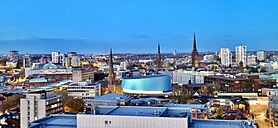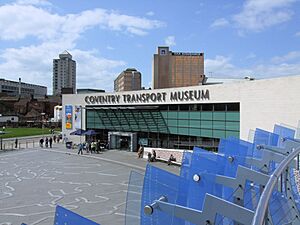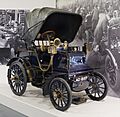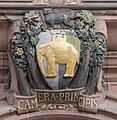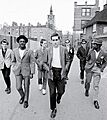Coventry facts for kids
Quick facts for kids
Coventry
|
|||
|---|---|---|---|
| City of Coventry | |||
|
|
|||
|
|||
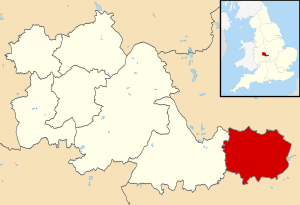
Shown within the West Midlands (county)
|
|||
| Sovereign state | United Kingdom | ||
| Country | England | ||
| Region | West Midlands | ||
| Ceremonial county | West Midlands | ||
| Historic county | Warwickshire | ||
| Administrative HQ | Council House | ||
| Founded | 1043 | ||
| Founded by | Leofric, Earl of Mercia | ||
| Areas of the city |
List
Alderman's Green
Allesley (Parish) Ash Green Ball Hill Bannerbrook Park Bell Green Binley Bishopsgate Green Brownshill Green Canley Cannon Park Chapelfields Cheylesmore Coundon Courthouse Green Daimler Green Earlsdon Eastern Green Edgwick Ernesford Grange Finham (Parish) Foleshill Gibbet Hill Great Heath Hearsall Common Henley Green Hillfields Holbrooks Keresley (Parish) Little Heath Longford Mount Nod Potters Green Radford Spon End Stoke Heath Stoke Aldermoor Stivichall Tile Hill Toll Bar End Walsgrave Westwood Heath Whitley Whitmore Park Whoberley Willenhall Wood End Wyken |
||
| Government | |||
| • Type | Metropolitan borough | ||
| • Body | Coventry City Council | ||
| Area | |||
| • City and metropolitan borough | 38.09 sq mi (98.64 km2) | ||
| Population
(2021)
|
|||
| • City and metropolitan borough | 345,324 | ||
| • Density | 11,400/sq mi (4,390/km2) | ||
| • Metro | 651,600 | ||
| Demonyms | Coventrian Coventarian |
||
| Ethnicity (2021) | |||
| • Ethnic groups |
List
|
||
| Religion (2021) | |||
| • Religion |
List
46.6% Christianity
31.6% no religion 11.1% Islam 5.3% Sikhism 4.3% Hinduism 0.6% other 0.4% Buddhism 0.1% Judaism |
||
| Time zone | UTC+0 (Greenwich Mean Time) | ||
| • Summer (DST) | UTC+1 (British Summer Time) | ||
| Postcode |
CV
|
||
| Area code(s) | 024 | ||
| ISO 3166-2 | GB-COV | ||
| ONS code | 00CQ (ONS) E08000026 (GSS) |
||
| NUTS 3 | UKG33 | ||
| Click the map for an interactive fullscreen view | |||
Coventry is a city in the West Midlands region of England. It is famous for its historic cathedral, which was rebuilt after being bombed in World War II. For many years, Coventry was a major centre for making cars and bicycles.
The city is located on the River Sherbourne. It has been an important place for hundreds of years, officially becoming a city in 1345. Today, Coventry is known for its history, its two universities, and its role as a city of peace. It was the UK City of Culture for 2021.
Contents
History
Early Times and Lady Godiva
The first known settlement near Coventry was a Roman fort at Baginton, built around AD 60. The modern city likely began as an Anglo-Saxon village. The name "Coventry" is thought to mean "Cofa's tree," named after a Saxon landowner.
In 1043, a nobleman named Leofric, Earl of Mercia and his wife, Lady Godiva, founded a monastery in Coventry. This is when the famous legend of Lady Godiva began. The story says she rode naked on a horse through the streets to protest high taxes her husband had placed on the people. While historians think the ride itself is a myth, Lady Godiva was a real and important person in Coventry's history.
A City of Great Importance
By the 13th century, Coventry was a rich and important city. It was a centre for the cloth trade, especially a type of blue cloth called "Coventry blue." During the Middle Ages, it was one of the largest cities in England.
To protect itself, the city built huge defensive walls that were finished in 1530. They were over 2 miles long and had 12 gates. Two of these gates, Swanswell Gate and Cook Street Gate, still stand today. Coventry was so important that the English Parliament sometimes met there, and it even served as a temporary capital city during the Wars of the Roses in the 1450s.
The Industrial Age: From Ribbons to Cars
In the 18th and 19th centuries, Coventry became famous for making silk ribbons, watches, and clocks. The city was filled with skilled workers who were experts at making small, precise parts.
After 1860, these industries declined, but a new one soon took over. A man named James Starley began making bicycles in the city. His company and others made Coventry the centre of the world's bicycle industry. By the 1890s, this skill in making bicycles led to the production of motor cars. The first British car was made in Coventry in 1897 by the Daimler Company. Soon, Coventry became the heart of the British motor industry, with famous brands like Jaguar, Rover, and Triumph being made there.
The World Wars and the Coventry Blitz
During both World War I and World War II, Coventry's factories were vital to the war effort, building vehicles, planes, and weapons. This made the city a target for enemy attacks.
During World War II, Coventry suffered terrible damage from German bombing. The worst attack was on the night of 14 November 1940, in a raid known as the Coventry Blitz. Much of the city centre was destroyed, including the historic St Michael's Cathedral. Hundreds of people were killed, and thousands of homes were destroyed. The city's destruction was so great that it gave rise to a new word in the German language, "coventrieren", meaning to completely destroy a town.
Rebuilding and Modern Times
After the war, Coventry was rebuilt. A new, modern city centre was created, including one of Europe's first pedestrian shopping areas. A new cathedral was built next to the ruins of the old one, as a symbol of peace and forgiveness.
The car industry boomed in the 1950s and 1960s, and Coventry became a very wealthy city. However, in the 1970s and 1980s, the industry declined, and many factories closed. This was a difficult time for the city, with high unemployment. This period inspired the famous song "Ghost Town" by the Coventry band The Specials.
In recent years, Coventry has recovered. It is now a modern city with a strong economy based on research, design, and its two large universities.
Geography
As with the rest of the British Isles, Coventry has a maritime climate with cool summers and mild winters.
| Climate data for Coventry (Coundon), elevation: 122 m (400 ft), 1991–2020 normals, extremes 1892–present | |||||||||||||
|---|---|---|---|---|---|---|---|---|---|---|---|---|---|
| Month | Jan | Feb | Mar | Apr | May | Jun | Jul | Aug | Sep | Oct | Nov | Dec | Year |
| Record high °C (°F) | 14.4 (57.9) |
18.1 (64.6) |
23.0 (73.4) |
26.7 (80.1) |
30.9 (87.6) |
32.4 (90.3) |
38.9 (102.0) |
35.1 (95.2) |
34.2 (93.6) |
28.2 (82.8) |
20.6 (69.1) |
16.4 (61.5) |
38.9 (102.0) |
| Mean daily maximum °C (°F) | 7.2 (45.0) |
7.9 (46.2) |
10.4 (50.7) |
13.6 (56.5) |
16.8 (62.2) |
19.7 (67.5) |
22.0 (71.6) |
21.5 (70.7) |
18.6 (65.5) |
14.3 (57.7) |
10.2 (50.4) |
7.5 (45.5) |
14.2 (57.6) |
| Daily mean °C (°F) | 4.5 (40.1) |
4.8 (40.6) |
6.8 (44.2) |
9.2 (48.6) |
12.2 (54.0) |
15.2 (59.4) |
17.3 (63.1) |
17.0 (62.6) |
14.4 (57.9) |
10.9 (51.6) |
7.2 (45.0) |
4.8 (40.6) |
10.4 (50.7) |
| Mean daily minimum °C (°F) | 1.8 (35.2) |
1.8 (35.2) |
3.1 (37.6) |
4.8 (40.6) |
7.7 (45.9) |
10.6 (51.1) |
12.6 (54.7) |
12.4 (54.3) |
10.3 (50.5) |
7.5 (45.5) |
4.4 (39.9) |
2.1 (35.8) |
6.6 (43.9) |
| Record low °C (°F) | −16.7 (1.9) |
−18.2 (−0.8) |
−15.6 (3.9) |
−6.1 (21.0) |
−5.0 (23.0) |
−0.6 (30.9) |
3.4 (38.1) |
0.8 (33.4) |
−1.1 (30.0) |
−4.9 (23.2) |
−8.9 (16.0) |
−16.1 (3.0) |
−18.2 (−0.8) |
| Average precipitation mm (inches) | 61.4 (2.42) |
46.8 (1.84) |
45.6 (1.80) |
49.1 (1.93) |
52.7 (2.07) |
65.8 (2.59) |
61.2 (2.41) |
66.2 (2.61) |
54.9 (2.16) |
68.7 (2.70) |
64.6 (2.54) |
61.3 (2.41) |
698.3 (27.49) |
| Average precipitation days (≥ 1.0 mm) | 12.0 | 10.2 | 9.8 | 9.8 | 9.3 | 9.3 | 9.1 | 9.6 | 9.5 | 10.7 | 12.2 | 11.7 | 123.3 |
| Mean monthly sunshine hours | 61.4 | 84.0 | 115.1 | 147.1 | 191.6 | 184.7 | 197.6 | 179.6 | 137.1 | 100.6 | 63.1 | 61.0 | 1,507.2 |
| Source 1: Met Office | |||||||||||||
| Source 2: BWS RMetS | |||||||||||||
| Climate data for Coventry Airport, 6km from Coventry | |||||||||||||
|---|---|---|---|---|---|---|---|---|---|---|---|---|---|
| Month | Jan | Feb | Mar | Apr | May | Jun | Jul | Aug | Sep | Oct | Nov | Dec | Year |
| Average relative humidity (%) | 86 | 83 | 79 | 75 | 74 | 73 | 72 | 74 | 78 | 83 | 87 | 88 | 79 |
| Average dew point °C (°F) | 2 (36) |
2 (36) |
3 (37) |
5 (41) |
7 (45) |
10 (50) |
12 (54) |
12 (54) |
10 (50) |
8 (46) |
5 (41) |
3 (37) |
7 (44) |
| Source: Time and Date (between 1985–2015) | |||||||||||||
Panoramic views of Coventry City Centre from the cathedral tower
What to See in Coventry
The Two Cathedrals
Coventry's most famous landmark is St Michael's Cathedral. The original 14th-century church was mostly destroyed by bombs in 1940. Only its outer walls and tall spire were left standing. The spire is one of the tallest in England.
A new, modern cathedral, designed by Sir Basil Spence, was built next to the ruins and opened in 1962. It is famous for its huge tapestry of Christ in Glory in the Tetramorph and a striking statue of St Michael's Victory over the Devil by Jacob Epstein. The new cathedral is a worldwide symbol of peace and reconciliation.
Museums and Culture
The Coventry Transport Museum is a popular attraction that celebrates the city's history of making cars, motorcycles, and bicycles. It has the largest public collection of British-made vehicles in the world, including the record-breaking cars Thrust2 and ThrustSSC.
The Herbert Art Gallery and Museum is another major cultural spot, with art collections and displays about Coventry's history. Just outside the city, you can visit the Lunt Fort, a reconstructed Roman fort that shows what life was like for Roman soldiers.
How Coventry is Run
Coventry is run by Coventry City Council. The council is made up of elected councillors who make decisions about local services. The head of the council is the Lord Mayor, a role that dates back hundreds of years.
Coventry is known as a "city of peace and reconciliation." After World War II, it formed a special friendship, or "twinning," with cities that had also suffered in the war. Its first twin city was Stalingrad (now Volgograd) in Russia. It later twinned with Dresden in Germany. Today, Coventry is twinned with 26 cities around the world to promote peace and understanding.
Arts and Culture
Music, Theatre, and Film
In the late 1970s, Coventry was the centre of a music style called 2 Tone. This music mixed Jamaican ska and reggae with punk rock. Famous 2-Tone bands from Coventry include The Specials and The Selecter. The city celebrates this history at the Coventry Music Museum.
The city also hosts the annual Godiva Festival, a free music festival in the War Memorial Park. The main theatre is the Belgrade Theatre, which was the first civic theatre built in Britain after World War II.
Coventry has also been a popular location for filming. A famous car chase scene in the 1969 movie The Italian Job was filmed in the city's large sewer pipes. More recently, the popular Christmas movies in the Nativity! series were filmed and set in Coventry.
Sport in Coventry
Coventry has a rich sporting history, with professional teams in football, rugby, and ice hockey.
The city's main football club is Coventry City F.C., known as the Sky Blues. They won the FA Cup in 1987, which is their biggest trophy. They play at the Coventry Building Society Arena.
The city's top ice hockey team is the Coventry Blaze. They play at the SkyDome Arena and have won the Elite Ice Hockey League championship four times.
| Club | Sport | Founded | League | Venue |
|---|---|---|---|---|
| Coventry City F.C. | Football | 1883 | EFL Championship | Coventry Building Society Arena |
| Coventry R.F.C. | Rugby union | 1874 | RFU Championship | Butts Park Arena |
| Coventry Blaze | Ice hockey | 2000 | Elite Ice Hockey League | SkyDome Arena |
Work and Industry
For centuries, Coventry's economy was based on manufacturing. It started with ribbon-making and then moved on to making clocks and watches. In the late 19th and 20th centuries, it became a world leader in making bicycles and then cars. Famous companies like Jaguar, Triumph, and Rover all had factories in the city. The famous London black cab taxis were also made in Coventry for many years.
Today, heavy industry is less important. While Jaguar Land Rover still has its headquarters and a research centre in the city, most of the big factories have closed. The modern economy of Coventry is now focused on business services, research, and design. The city's two universities, Coventry University and the University of Warwick, are now major employers.
Transport
Coventry is located near several major motorways, including the M6, M1, and M40. A unique feature of the city is its ring road, the A4053, which forms a circle around the city centre. It was built in stages between 1962 and 1974.
Coventry railway station is on the West Coast Main Line, providing fast train services to London, Birmingham, and other major cities. The city's main bus station is Pool Meadow. The Coventry Canal also ends near the city centre, providing a waterway link for canal boats.
Education
Coventry is home to two universities. Coventry University has its campus in the city centre, while the University of Warwick is located on the southern edge of the city. The University of Warwick is one of the top-ranked universities in the UK. The city also has several further education colleges and many primary and secondary schools.
Images for kids
-
St Mary's Guildhall, a medieval building from the 14th century that survived the bombing.
See also
 In Spanish: Coventry para niños
In Spanish: Coventry para niños


